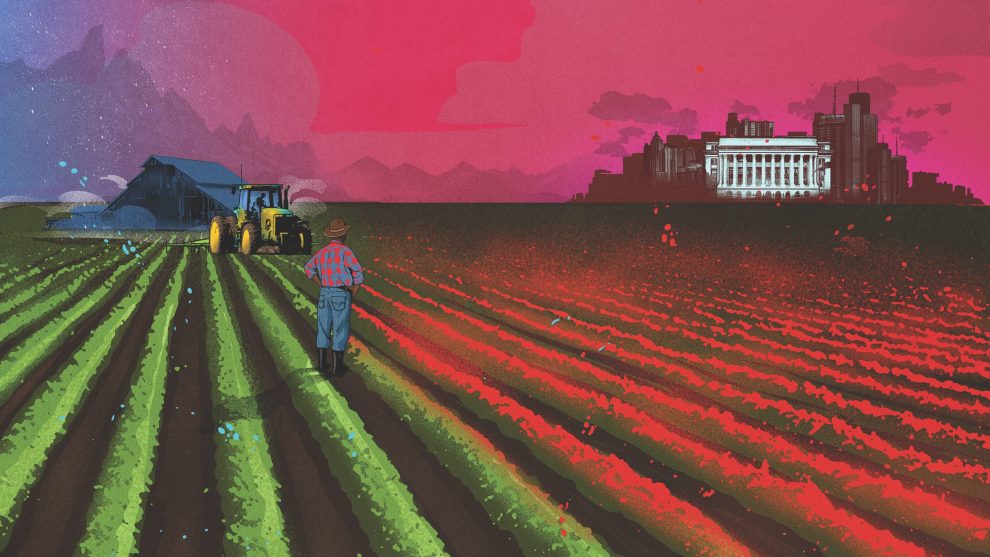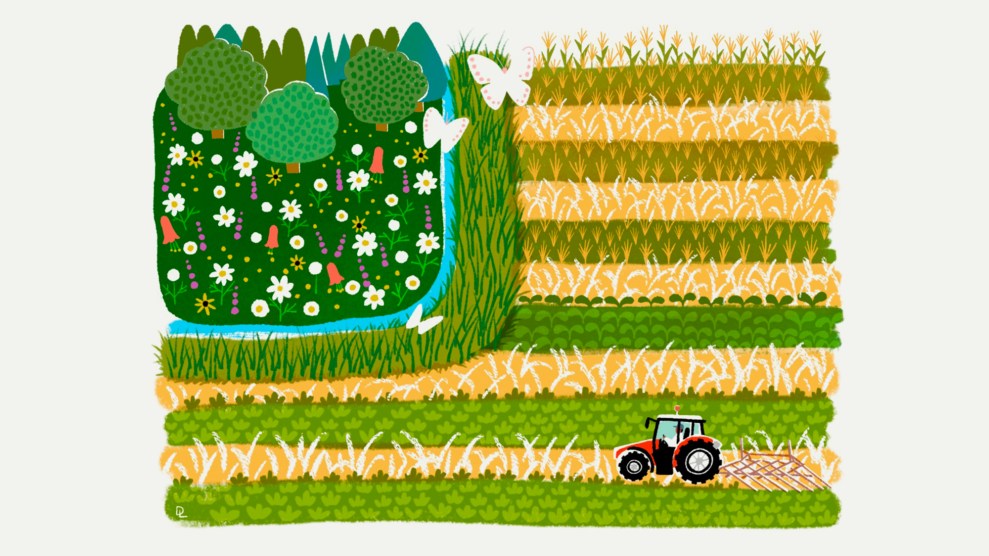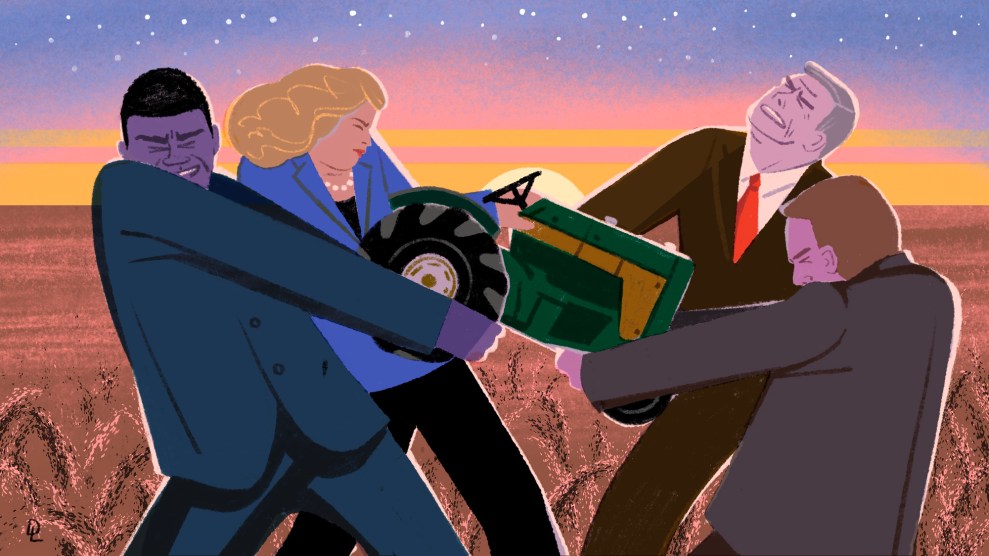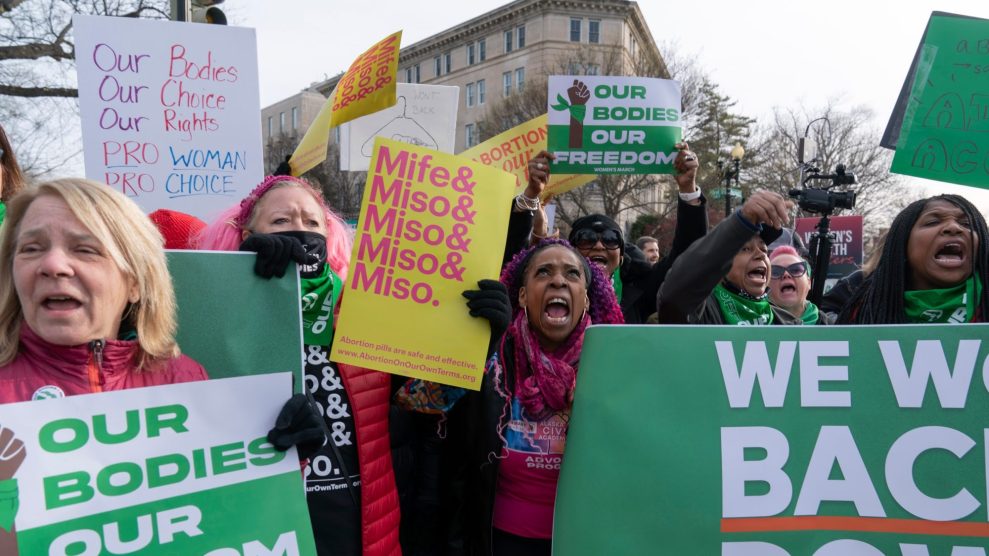The farm bill is one of the most important but least understood pieces of US legislation, and it’s overdue for renewal. But Congress couldn’t pass a new version in the fall, reflecting partisan dysfunction and also a contentious debate about what the bill ought to be—a debate that has become ensnared in the nation’s culture wars. Racial equity, food sovereignty, protections for workers, and meaningful action on climate change have broadened the bill’s traditional mandate of growing food and feeding hungry people. In this special series, a partnership with the Food and Environment Reporting Network, we’ll be exploring some of the urgent issues a new farm bill must address. Read the other stories in the series here.
The farm bill is among the most important pieces of legislation that Congress is more or less obliged to pass. Yet to all but a handful of people whose job it is to parse its every incremental gain or loss, it is largely inscrutable. Every five years we’re treated to bitter fights over things like the use and abuse of agricultural subsidies; attempts to defund SNAP; the notion that environmental stewardship should guide farm policy as much as increasing production; and how (and sadly whether) to build equity into an agriculture system with a racist history.
But the backstories to these fights, some ill-fated and others shameful, can provide important context and help to clarify exactly what’s at stake. Over the last 90 years there have been several key farm bill moments, the consequences of which shape the debates ongoing today.
The farm bill’s original sin
The story of the farm bill is one of Black land dispossession and persistent racial inequality in American agriculture. It was baked into the first farm bill, and it has never been made right. Faced with the twin crises of the Dust Bowl and the Great Depression, the Roosevelt administration was determined to help ailing farmers. But in the rush to pass the 1933 Agricultural Adjustment Act (AAA), the era’s most dramatic piece of farm legislation, FDR sided with Southern plantation owners, who wanted to raise crop prices, and farm income, by paying farmers to plant fewer acres.
This was disastrous for Black farmers. As Jonathan Coppess writes in The Fault Lines of Farm Policy, historians argue that the AAA was “designed and used intentionally to help southern cotton planters push poor black sharecroppers off the land and consolidate their holdings.”
Only landowners could sign government contracts that paid farmers to plow up their fields, and the vast majority of Black farmers were tenants or sharecroppers. White landowners were supposed to share the payments they got with their renters and sharecroppers, but few did. Others purposefully signed crop subsidy contracts only when they didn’t have tenant or sharecropper agreements, to avoid sharing the wealth.
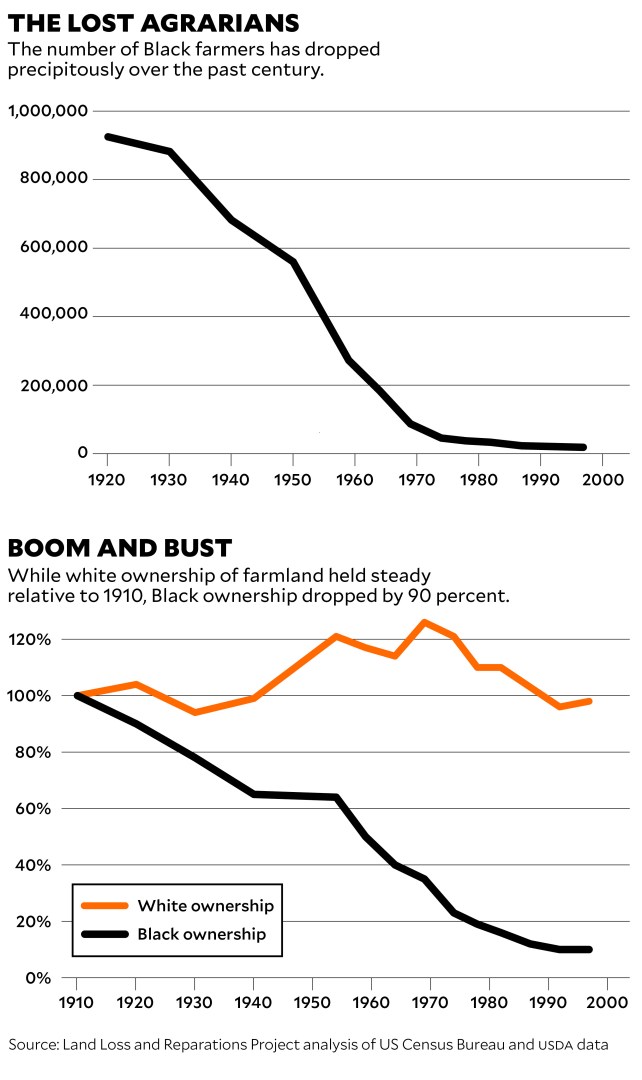
“Whether the share-cropper received any payment or any credit allowance for the cotton plowed up on his patch depended upon the tender mercies of his landlord,” wrote Webster Powell and Addison T. Cutler in Harper’s in 1934. “We encountered a number of cases where the landlord arranged with the government to plow up all of the patch operated by an individual cropper and followed this up by closing the books with the cropper and sending him ‘down the road.’”
All told, the largest farms maintained or even increased their harvests while farming less land, and farmers on rented land went out of business. Between 1930 and 1935, land owned by white farmers increased by 35 million acres while land owned by all other farmers decreased by more than 2 million acres. Over the next twenty years the number of Black farmers dropped 37 percent.
The AAA was just the beginning. Decades of racist policies followed, driving further dispossession, including discriminatory USDA lending and the denial of title and other property rights. Between 1910 and 1997, Black farmers lost 90 percent of their farmland. Today, Black farmers own less than 1 percent of total US farmland.
This year, a group of Senate Democrats, led by Cory Booker of New Jersey, is pushing for the Justice for Black Farmers Act, first introduced in 2020, to be included in the next farm bill. The legislation’s aim is ambitious: “[E]nd discrimination within the USDA, protect remaining Black farmers from losing their land, [and] provide land grants to create a new generation of Black farmers.”
It would be fitting if the farm bill, once used to solidify racial inequality, becomes the vehicle to right that historical wrong.
The birth of huge
The number of American farms has dropped from 6.8 million in 1935 to 2 million today. The remaining farms have gotten a lot bigger, with the median operation managing 445 acres and the largest 11 percent producing 82 percent of all farm goods. Large farms deal with similarly massive agribusiness companies that control seeds, fertilizer, and other things farmers need. Together, this so-called “Big Ag” system dominates our food supply, prioritizing yields and efficiency over high-quality food, a healthy environment, and rural development.
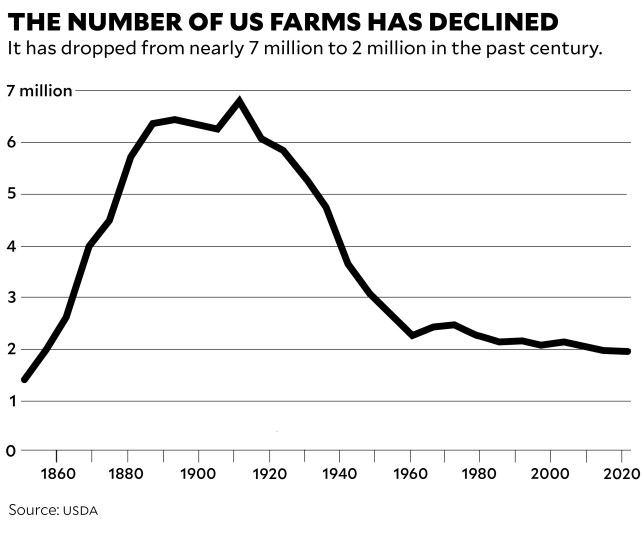
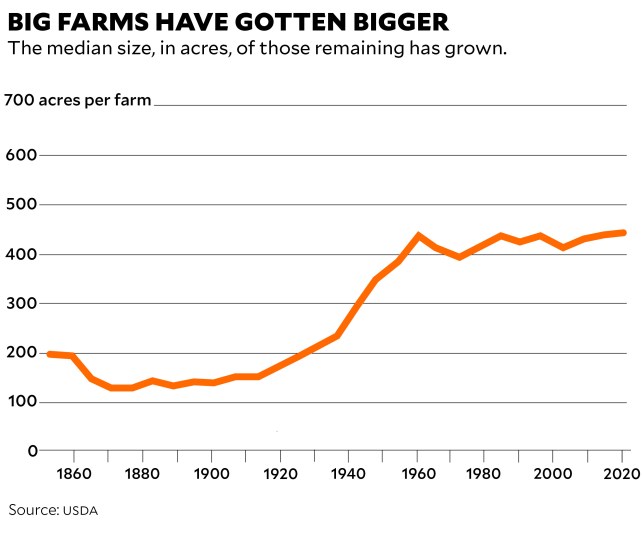
How did this happen? The conventional wisdom blames Earl Butz, Richard Nixon’s Secretary of Agriculture, who reportedly urged farmers to “get big or get out” (though there is scant evidence that he actually said it). Regardless, most farm consolidation had already happened by the time Butz took the reins at the department of agriculture in 1971.
Some of the consolidation was made possible by technological advancements that exploded yields in the post-war era, like rural electrification and better seed breeding. But the farm bill, and ag policy broadly, also favored large farms over smaller ones.
Even before the New Deal, agricultural officials envisioned a system of large, mechanized farms—the kinds of operations that needed fewer people to do the work. So when the federal money started flowing in the 1930s, most of it went to the big players who used it to invest in tractors and other technology that allowed them to get even bigger. For instance, FDR ended the 1931 “feed and seed” loans that many small farmers and tenants relied on in favor of federal lending programs with steep collateral requirements that small farmers couldn’t meet. As small cotton farmers told Harper’s in 1934, “The only thing they haven’t got a mortgage on is my wife and kids.”
Even though Republicans and Democrats bemoaned the “farm problem,” or the rapid loss of farms that continued through the 1950s and into the 1970s, neither party summoned the political will to try more aggressive interventions that some states were experimenting with, like limiting corporate farmland ownership. And anti-communist Cold War sentiment shut down any consideration of collective farming or land redistribution.
Late New Deal policy did aim to create a fair price floor for all farmers and discourage the overproduction that drove prices down. But policymakers never quite struck the right balance between preventing overproduction and ensuring that farms of all sizes were able to access federal support and stay afloat.
When Eisenhower and his agriculture secretary, Ezra Taft Benson, lowered New Deal price floors in 1954 and ended corn production controls in 1959, surpluses grew, prices fell, and larger farms were able to survive on those lower prices while smaller ones could not. The Kennedy administration made one last effort to support crop prices by limiting production, but wheat farmers killed it in the famous 1963 wheat referendum. The president of the American Farm Bureau Federation, the nation’s biggest agricultural lobbyist that had led the charge against the referendum, called the defeat “a major turning point in the continual battle…between those who believe in an agriculture producing for the competitive market and those who favor Government supply management.”
So farm policy inched closer and closer to unfettered production for low market prices, and the “farm problem” got worse. The debate simmers on today. The clamor to do something about consolidation in the next farm bill includes a proposal for an “Office of Small Farms” that would “ensure that all USDA programs are designed to meet the needs of small farmers.”
Show me the money
The farm bill has always allowed big farms to take more than their fair share of federal subsidies and use the extra cash to outcompete smaller farms. This inequity has gotten worse since the 1970s, when the farm bill stopped trying to raise market prices as a way to help farmers and instead started making direct payments to them.
The problem is that direct payments don’t make it to the people who need them the most. Between 1995 and 2021, the top 10 percent of subsidy recipients—the largest and wealthiest farms—got more than 78 percent of commodity program payments, and the top 1 percent received a whopping 27 percent. To date, every effort to set a reasonable cap on subsidy payments for large farms has failed, stymied by the power of the ag lobby and its allies in Congress.
Congress nearly passed subsidy limits in the 2014 farm bill cycle. Legislation included a $50,000 limit, stricter requirements that recipients be “actively engaged in farming” to prevent non-farmers from receiving payments, and a modest limit on crop insurance subsidies for the richest farms. Sen. Thad Cochran from Mississippi, the ranking GOP member of the Senate Agriculture Committee, who was facing a primary challenge, reportedly managed to nix the limit before the final bill was passed as part of an effort to shore up his support back home.
In May 2023, the Des Moines Register published an op-ed that called for a farm bill that ensured that subsidies go to “actual farmers instead of the current practice of sending endless subsidies to millionaires, billionaires, nonfarmers, and absentee owners who often live in big cities or even foreign countries.” It could have been written fifty years ago.
Feeding the crop insurance beast
In February 2023, the Government Accountability Office reiterated its longstanding plea for Congress to rein in the soaring costs of federal crop insurance, which have more than quadrupled since 2005. Since 1938 the federal government has subsidized insurance for farmers to protect against losses from things like poor harvests, a drop in market prices, and extreme weather. But until the 1990s, crop insurance subsidies were a marginal part of the farm safety net; today they’re the second most expensive program in the farm bill (after SNAP).
The GAO didn’t say it, but it’s reasonable to ask: Why, as the impact of climate change is impossible to ignore, are taxpayers paying farmers billions to grow thirsty and other failure-prone crops, such as cotton and alfalfa, in the desert Southwest. And why are private insurance companies raking in taxpayer money to cover them?
Here’s why. In 1996, Sen. Pat Roberts’ “Freedom to Farm” bill turned most crop subsidies into fixed payments, unrelated to market prices. It also increased federal subsidies for private crop insurance, so that if farmers wanted extra income guarantees they could pay to insure their profit margin or their crops. When crop prices collapsed one year into the Freedom to Farm plan, the new fixed payments proved paltry, driving more farmers to buy crop insurance and demand ad hoc emergency government payouts—which they got, to the tune of $30 billion between 1998 and 2002.
After shelling out for emergency payments, Congress doubled down on pushing farmers to buy crop insurance and gave them even more money to cover premiums. At the end of 1994, there were 90 million acres covered by crop insurance; today nearly 500 million acres are covered. Taxpayers pay roughly 60 percent of farmers’ insurance premiums, even as plans become more expensive due to rising crop failures due to climate change.
This system has one big winner: private crop insurance companies. GOP leadership—including Pat Roberts—snuck a provision into the 2014 farm bill that prevents the government from ever spending less money to subsidize crop insurance. The law effectively locks in high profits for insurers.
And how about those cotton growers in the desert? Since 2001, heat linked to climate change has driven $1.33 billion in insurance payouts to farmers across the Southwest for crops that failed amid high temperatures. And that number is only going to grow. Risky, environmentally sensitive, and less-productive farmland can get the same crop insurance subsidy as highly productive land, even though it’s more likely to underperform and require an insurance payout. With these incentives, farmers converted into crop land millions of acres of less-productive, drought-prone grasslands and sensitive wetlands that likely would not have been farmed. An analysis by the Environmental Working Group estimates that over 23 million acres of grassland, shrub land, and wetlands were turned into crop land between 2008 and 2011.
What climate crisis?
Beyond the perennial call for deep cuts to SNAP, one of the biggest obstacles to a new farm bill this year is an effort by House Republicans to hijack $20 billion of funds from Biden’s big climate bill, the Inflation Reduction Act, earmarked for agriculture climate-mitigation projects and use them to fatten crop subsidies.
You may think that this is a singular bit of crazy generated by the chaos that engulfed the House GOP last fall. But in fact it is merely the latest in the ongoing degradation, via the farm bill, of farmers’ ability to mitigate the climate crisis.
Farm bill conservation policy is split into “land retirement” programs, like the Conservation Reserve Program, which pay farmers to take erosion-prone or environmentally sensitive land out of production, and “working lands” programs, such as the Environmental Quality Incentives Program (EQIP) and the Conservation Stewardship Program (CSP), which pay farmers to adopt more sustainable practices.
In the run-up to the 2014 farm bill, the conservation programs came under fire as Tea Party Republicans refused to increase the debt ceiling and demanded significant spending cuts. In the face of this pressure, a small group of congressional leaders struck a deal, sometimes called the “Secret Farm Bill,” which agreed to $23 billion in farm program cuts over ten years. When the 2014 law finally emerged, conservation spending had been cut by $6 billion, or nearly 10 percent over ten years.
These changes sent US agriculture backward at a time when farms needed and wanted support to conserve biodiversity and reduce air and water pollution. An analysis by the Environmental Working Group, for instance, found that between 2017 and 2020, only 23 percent of EQIP funds supported practices deemed “climate-smart” by USDA. And even without the cuts, EQIP and CSP do not prioritize practices that reduce greenhouse gas emissions.
To make matters worse, every conservation program except CRP is subject to further cuts through the annual federal budget setting process. The year after the 2014 farm bill passed Congress gave all conservation programs (other than CRP) 7 percent less money than originally stipulated. All told, the National Sustainable Agriculture Coalition estimates that these budgeting processes will have cut another $2 billion in conservation spending between 2014 and 2024.
So even if Democrats manage to hang on to the billions earmarked for conservation in the Inflation Reduction Act, it will just barely make up for cuts made a decade ago. Such is the perverse reality of the farm bill.

